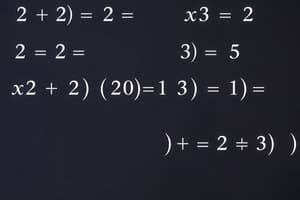Podcast
Questions and Answers
What is the simplified form of $\sqrt{36a^6b^2}$?
What is the simplified form of $\sqrt{36a^6b^2}$?
- $12a^3b$
- $6a^2b$
- $36ab$
- $6a^3b$ (correct)
What is the result of simplifying $\frac{\sqrt{72x^4y}}{x^2}$?
What is the result of simplifying $\frac{\sqrt{72x^4y}}{x^2}$?
- $6x\sqrt{2y}$ (correct)
- $3x^2\sqrt{2y}$
- $6\sqrt{2}$
- $12\sqrt{2y}$
Calculate the distance between the points (-5, 6) and (-3, -4).
Calculate the distance between the points (-5, 6) and (-3, -4).
- $8$
- $10$ (correct)
- $12$
- $14$
What is the final result of $14\sqrt{3} + 5\sqrt{2} - 5\sqrt{3} - 6\sqrt{2}$?
What is the final result of $14\sqrt{3} + 5\sqrt{2} - 5\sqrt{3} - 6\sqrt{2}$?
What is the result of $(5 - \sqrt{3})(5 + \sqrt{3})$?
What is the result of $(5 - \sqrt{3})(5 + \sqrt{3})$?
What is the simplified form of $\sqrt{121}$?
What is the simplified form of $\sqrt{121}$?
What is the result of simplifying $\sqrt{(-7)^{2}}$?
What is the result of simplifying $\sqrt{(-7)^{2}}$?
What is the simplified form of $\sqrt{(xy)^{2}}$?
What is the simplified form of $\sqrt{(xy)^{2}}$?
What is the simplified form of $\sqrt{(6x-7)^{2}}$?
What is the simplified form of $\sqrt{(6x-7)^{2}}$?
What is the simplified form of $-3\sqrt{108}$?
What is the simplified form of $-3\sqrt{108}$?
What is the result of the expression $4i(2-3i)$?
What is the result of the expression $4i(2-3i)$?
What is the product of the complex numbers $(2+3i)(5-2i)$?
What is the product of the complex numbers $(2+3i)(5-2i)$?
Which of the following is a correct statement about the function $x^{2} + 25 = 0$?
Which of the following is a correct statement about the function $x^{2} + 25 = 0$?
When multiplying two complex numbers, $(2+3i)$ and $(5-2i)$, which operation is used?
When multiplying two complex numbers, $(2+3i)$ and $(5-2i)$, which operation is used?
What does $i$ represent in complex numbers?
What does $i$ represent in complex numbers?
What is the simplified form of $16^{1/2}$?
What is the simplified form of $16^{1/2}$?
What is the result of $6^{1/2} imes 6^{3/2}$?
What is the result of $6^{1/2} imes 6^{3/2}$?
How do you write $72^{1/2}$ in its simplest form?
How do you write $72^{1/2}$ in its simplest form?
What is the complex number $5 -
rac{ ext{sqrt}(-16)}{1}$ in standard form?
What is the complex number $5 - rac{ ext{sqrt}(-16)}{1}$ in standard form?
What is the solution to the equation $ ext{sqrt}(x-5) + 4 = 8$?
What is the solution to the equation $ ext{sqrt}(x-5) + 4 = 8$?
What is the simplified form of $
rac{2 ext{√}3x}{ ext{√}6xy}$?
What is the simplified form of $ rac{2 ext{√}3x}{ ext{√}6xy}$?
What is the radical form of $11^{1/2}$?
What is the radical form of $11^{1/2}$?
What is the expression $
rac{ ext{√}3}{ ext{√}2 + 1}$ rationalized?
What is the expression $ rac{ ext{√}3}{ ext{√}2 + 1}$ rationalized?
What is the evaluation of $2^{2/3}$ in radical form?
What is the evaluation of $2^{2/3}$ in radical form?
What is the simplified form of $a^{-4/5}$?
What is the simplified form of $a^{-4/5}$?
Study Notes
Simplifying Radicals
- Understanding square roots:
- The square root of a number is a value that, when multiplied by itself, equals the original number.
- For example, the square root of 121 is 11 because 11 * 11 = 121.
- Simplifying square roots:
- Find the largest perfect square that divides the radicand (the number under the radical sign).
- For example, √125 can be simplified as √(25 * 5) = √25 * √5 = 5√5.
- Simplifying radicals with variables:
- Apply the rule √(a^2) = |a| for any real number a.
- For example, √(x^2) = |x|.
- Simplifying radicals with fractions:
- Apply the rule √(a/b) = √a / √b (for both a and b nonnegative).
- For example, √(81/16) = √81 / √16 = 9/4.
Adding and Subtracting Radicals
- Combining like radicals:
- Radicals can only be added or subtracted if they share the same radicand and index (the small number outside the radical sign).
- For example, 3√2 + 5√2 = 8√2.
Multiplying Radicals
- Multiplying roots:
- Apply the rule √a * √b = √(a * b).
- For example, √6 * √15 = √(6 * 15) = √90 = √(9 * 10) = 3√10.
- Squaring a radical:
- Apply the rule (√a)^2 = a.
- For example, (√7)^2 = 7.
Dividing Radicals
- Dividing roots:
- Apply the rule √a / √b = √(a/b) (for both a and b nonnegative).
- For example, √72 / √2 = √(72/2) = √36 = 6.
- Rationalizing the denominator:
- To eliminate radicals from the denominator, multiply both the numerator and denominator by the radical's conjugate. The conjugate of √a + √b is √a - √b.
- For example, to rationalize the denominator of √3 / (√2 + 1), multiply by (√2 - 1) / (√2 - 1).
Fractional Exponents
- Understanding fractional exponents:
- A fractional exponent like x^(m/n) represents a radical expression where the numerator (m) is the power and the denominator (n) is the root.
- For example, x^(2/3) = (∛x)^2.
Complex Numbers
- Understanding complex numbers:
- Complex numbers involve the imaginary unit 'i', where i² = -1.
- A complex number is in the form a + bi, where a and b are real numbers.
- Operations on complex numbers:
- Addition/Subtraction: Combine real and imaginary parts separately.
- Multiplication: Use the distributive property (like multiplying binomials), remembering that i² = -1.
- Division: Rationalize the denominator by multiplying both the numerator and denominator with the complex conjugate of the denominator.
- The complex conjugate of a + bi is a - bi.
Solving Radical Equations
- Isolate the radical term: Combine terms to bring the radical term to one side of the equation.
- Square both sides: Eliminate the radical by squaring both sides of the equation. Remember to check for extraneous solutions, as squaring both sides can introduce them.
- Solve the resulting equation: Solve the quadratic equation to find the possible values of the variable.
Distance Formula
- Distance between two points: The distance between two points (x₁, y₁) and (x₂, y₂) is found using the distance formula: √((x₂ - x₁)² + (y₂ - y₁)²).
Studying That Suits You
Use AI to generate personalized quizzes and flashcards to suit your learning preferences.
Description
Test your knowledge on simplifying radicals, including square roots, radicals with variables, and fractions. Additionally, explore how to add and subtract like radicals. This quiz will help reinforce your understanding of these important algebraic concepts.




